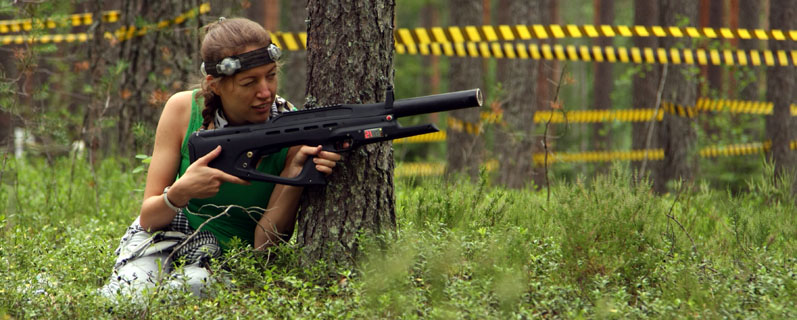Active
Creative
Quests
Smart
Sports
Water
Auto-Moto
Military
Incentive: 2 days
Incentive: Russia
Incentive: world
Evening party
Laser Tag
Program
Laser Tag - literally "light mark". Initially, an electronic-mechanical system installed on small arms to simulate combat operations during the training of special forces soldiers. It consists of an "emitter" (actually a "laser" - a laser diode, in fact - a powerful light bulb installed in a pipe) and a "receiver" - an electronic sensor that registers a change in illumination. The emitter is attached to the weapon, the receiver - somewhere on the fighter's body (usually on the head with a bandage), and voila - you can train without the risk of injury.
The equipment for playing laser tag also consists of a "tagger" - having a real weight and an impressive appearance, and a headband connected by a wire. When fired, the tag gun makes characteristic sounds, but, unlike paintball, nothing flies anywhere - just a laser diode fires inside the tag gun, and if the tag gun is aimed towards the enemy, a hit is recorded on the enemy’s head sensor - the player is defeated. Thus, they play laser tag without masks, in any clothes (clothing does not get dirty), anywhere - in the forest, at a recreation center, on the street. This is one of the main advantages of laser tag - the ability to use any territory for team building, as well as the presence of "civilians" - not participating in the game, but located on the territory.
Each tagger can be configured in different ways - to have a different number of "charges", different striking ability, to have an optical or collimator sight.
To play laser tag, as well as in paintball, various scenarios are used - "wall to wall", "capture the flag", "defense-attack", "cleansing". Light, pyrotechnic products and other equipment can be used. To organize spawn points, electronic blocks are used that restore energy and charges in the equipment of fighters. "Field kits" and electronic "points" for capture and retention may also be used (depending on the scenario).

The main pros and cons of laser tag compared to paintball:
Pros:
- Safety is higher than in paintball - there are no bruises from hitting the balls.
- No need to wear a mask and special clothing.
- You can play on any territory - with buildings, equipment, civilians. Since you do not need to wear a mask, you can safely use multi-storey buildings and control players with various equipment.
- The range of the equipment is much greater than in paintball - up to 150 meters. Thus, the playing area can be much larger.
- The battery charge in the equipment is enough for 4-5 hours of active play - no need to refuel air and balls.

Cons:
- Because there is no pain (anything at all) when "losing" - the game does not feel as sharp as playing paintball.
- Because the equipment is electrical - it is more affected by the weather (rain, snow, low temperatures), in bad weather conditions and inaccurate handling, the equipment may become unstable.
- There is the possibility of "cheating" - for example, closing the sensors, while the player becomes invulnerable - the referees need to clearly control the players.
In general, laser tag is a good addition to the traditional game of paintball, for certain tasks.
